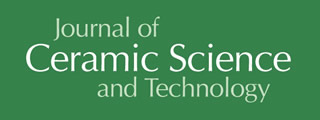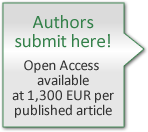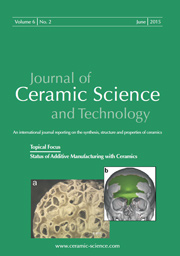Articles
All articles | Recent articles
Thermography and Complementary Measurements as Tools to Detect Micro-Irregularities in Electronic Components
S. Röhrig1,2, I. Petschenig1,2, R. Bermejo1, M. Hofstätter1, F. Aldrian3, R. Danzer1, P. Supancic1,2
1 Institut für Struktur- und Funktionskeramik, Montanuniversitaet Leoben, Austria
2 Materials Center Leoben Forschung GmbH, Leoben, Austria
3 EPCOS OHG, Deutschlandsberg, Austria
received September 1, 2015, received in revised form October 19, 2015, accepted November 19, 2015
Vol. 6, No. 4, Pages 255-260 DOI: 10.4416/JCST2015-00052
Abstract
In many ceramic components for electrical applications, small defects in the microstructure may cause an anomalous current flow. Especially in components exhibiting nonlinear electro-thermal properties, such as varistors, positive (PTC) or negative (NTC) temperature coefficient resistors, inhomogeneities lead to high concentrations of current and localized heat generation owing to positive feedback effects. While the integral behaviour of those components is largely unaffected by these defects, the local load at these hot spot regions is extremely high and can even lead to the complete failure of the device. In this work, microanalytical tools are combined to identify the location and type of defects that may cause leakage currents, overheating or other reasons for inhomogeneous current distributions in functional ceramic components. Lock-in thermography is used to localize dominating current paths. This is even possible if the heat sources are in the micrometer range or smaller. Additionally, microsectioning techniques (e.g. Focused Ion Beam) are utilized to expose such regions in order to investigate features of the microstructure and causes for the enhanced current flows. Examples are shown with PTC resistor components as well as Low-Temperature Co-fired Ceramic (LTCC)-based modules.
![]() Download Full Article (PDF)
Download Full Article (PDF)
Keywords
Electroceramics, PTC, LTCC, inhomogeneities, microthermography, focused ion beam
References
1 Davidge, R.W.: Mechanical behaviour of ceramics. Cambridge University Press, Cambridge, 1979.
2 Soma, T., Ishida, Y., Matsui, M., Oda, I.: Ceramic component design for assuring long-term durability, Adv. Ceram. Mater., 2, 809 – 812, (1987).
3 Morrell, R.: Handbook of properties of technical & engineering ceramics, Part 1: An introduction for the engineer and designer. Her Majesty's Stationery Office, London, 1989.
4 Munz, D., Fett, T.: Ceramics. Mechanical properties, failure behaviour, materials selection. Springer, Berlin, 1999.
5 Geier, G., Rosc, J., Hadwiger, M., Fritz, L., Habe, D., Pabel, T., Schumacher, P.: Assessing casting quality using computed tomography with advanced visualization techniques. In Shape Casting: 3rd International Symposium. 2009.
6 Buse, G., Wu, D., Karpen, W.: Thermal wave imaging with phase sensitive modulated thermography, J. Appl. Phys., 71, 3962 – 3965, (1992).
7 Breitenstein, O., Langenkamp, M., Altmann, F., Katzer, D., Lindner, A., Eggers, H.: Microscopic lock-in thermography investigation of leakage sites in integrated circuits, Rev. Sci. Instrum., 71, 4155 – 4160, (2000).
8 Breitenstein, O., Watrta, W., Langenkamp, M.: Lock-in thermography: Basics and use for evaluating electronic devices and materials. 2nd ed. Springer, 2010.
9 Hofstätter, M., Nevosad, A., Teichert, C., Supancic, P., R.: Voltage polarity dependent current paths through polycrystalline ZnO varistors, J. Eur. Ceram. Soc., 33, 3473 – 3476, (2013).
10 Hofstätter, M., Raidl, N., Sartory, B., Supancic, P.: Nonlinear lock-in infrared Microscopy: A complementary investigation technique for the analysis of functional electroceramic components, Microsc. Microanal., 21, [5], 1145 – 1152, (2015).
11 Raidl, N., Supancic, P., Danzer, R., Hofstätter, M.: Piezotronically modified double Schottky barriers in ZnO varistors, Adv. Mater., 27, [12], 2031 – 2035, (2015).
12 Cielo, P., Maldague, X., Déom, A.A., Lewak, R.: Thermographic non-destructive evaluation of industrial materials and structures, Mater. Eval., 45, 452 – 460, (1987).
13 Maldague, X., Marinetti, S.: Pulse phase infrared thermography, J. Appl. Phys., 79, 2694 – 2698, (1996).
14 Giorleo, G., Meola, C.: Location and geometry of defects in composite laminates from infrared images, ASM Int. J. Magn. Eng. Perf., 7, 367 – 374, (1998).
15 Oswald-Tranta, B.: Time-resolved evaluation of inductive pulse heating measurements, Quant. Infrared Thermogr. J., 6, [1], 3 – 19, (2009).
16 Sakagami, T., Kubo, S.: Applications of pulse heating thermography and lock-in thermography to quantitative nondestructive evaluations., Infrared Phys. Technol., 43, [211 – 218], (2002).
17 Meole, C., Carlomagno, G.M., Squillace, A., Vitiello, A.: Non-destructive evaluation of aerospace materials with lock-in thermography, Eng. Fail. Anal., 13. 380 – 388, (2006).
18 Heywang, W.: Semiconducting barium titanate, Mater. Sci., 6, 1214 – 1224, (1971).
19 Moulson, A.J., Herbert, J.M.: Electroceramics. Chapman & Hall, London, Weinheim, New York, Tokyo, Melbourne, Madras, 1997.
20 Supancic, P.: Mechanical stability of BaTiO3-based PTC thermistor Components: experimental investigations and theoretical modelling, J. Eur. Ceram. Soc., 20, [12], 2009 – 2024, (2000).
21 Imanaka, Y.: Multilayered low temperature cofired ceramics (LTCC) technology. In, New York, NY 10013, USA, 2005.
Copyright
Göller Verlag GmbH


